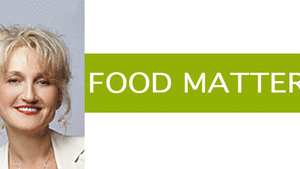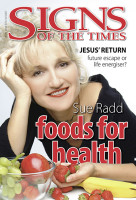Sue Radd is vivacious at 41, likely as a result of practising what she preaches with respect to healthful living.
Signs readers have gotten to know her through her food and nutrition advice dispensed in more than 100 “Food matters” columns over the past 10 years.
Her lifelong passion for good food and nutrition began as a child in Europe, watching her Croation grandmother cooking in the kitchen. “I remember happy days with her in the kitchen and garden, making food from scratch. For example, I remember making noodles for soup, hanging them off chairs in the kitchen to dry before cutting them into fine strips. She also raised chooks (free-range, of course) and after you'd killed one, you'd put it into scalding hot water and pluck their feathers—something I shudder to think about these days. But that was an instrumental time in establishing my interest in foods and connecting me to their source.
I've always been intrigued by the human body and in high school, I discovered that the one place where foods and the body came together was in the field of nutrition and dietetics. And that's why I became a dietitian.”
After studying biochemistry at university, Sue did postgraduate studies in dietetics. Today she is an Accredited Practising Dietitian and Registered Nutritionist, and with two other specialist staff runs a practice—the Nutrition and WellBeing Clinic, which she founded in Sydney's north west.
“We counsel patients referred by doctors— people suffering food-related problems, such as allergies, irritablebowel syndrome and type 2 diabetes— but we also work with a lot of healthy people, who are simply seeking advice on avoiding disease—especially if they have a family history of health problems.
Others are elite athletes, training for events and wanting the right food to fuel their bodies.”
“While our focus is on food, we also offer lifestyle advice that's more rounded and holistic, such as tips on getting adequate rest and physical activity. We also provide consultancy services to corporate clients in the food industry, pharmaceutical companies and even law firms.”
Sue's specialty lies beyond the vitamins, minerals and fibre of foods— the things we've known about for years. It's the more recent things research has uncovered—the so-called phyto-nutrients.
“They were ignored for many years, because they're found in such small amounts,” explains Sue, warming to her rather technical topic. “They're the thing that gives food its flavour and colour. Those bright vibrant colours aren't just there for good looks—they have a real purpose. Phyto-nutrients protect the plant from disease but importantly, they also protect us from the chronic or lifestyle diseases so prevalent today.”
In fact, Sue has co-authored a book on the topic with the world's pre-eminent expert in the field, Dr Kenneth Setchell,called Eat to Live (Hodder, 2002) which explains the details of phyto-protection, and how phyto-nutrients help reduce the risk of cancers and heart disease. That sounds a bit confronting but Eat to Live is easily digested, so to speak, and includes FAQs, reference tables, a glossary for the nonexpert, and best of all, recipes.
“The stimulus to write on the topic came from the huge interest we observed while speaking at international meetings, and answering frequent media and consumer questions.
We wanted to sort out the misunderstandings and myths about phytoestrogens— as the ‘smart' natural molecules are often mistaken for estrogens. Also we wanted to show just how easy it is to eat in a phytoestrogen-rich way, by providing meal plans, shopping lists and delicious recipes.”
It was while she was being interviewed with Setchell on British radio about the topic that the interviewer asked if either of them had a book on the topic. It took some years for the idea to go from typewriter to the cooktop, as both live extremely busy lives.
Sue is also the author of The Breakfast Book (Hodder), which was awarded the Food Media Award for Best Nutrition Writing in 2003. Sue says the award came as a big surprise. “I was in quite a bit of shock. It was very special to receive that from my peers. Feedback from readers has been good too, the best one being a guy who uses it as his ‘bible' of food and tells me he feels much better as a result. It's gratifying to realise you are making a difference.”
Although once a meat eater, these days Sue is a vegetarian—”
an almost vegan,” she says, as she has an occasional free-range egg or low-fat yoghurt. Her interest in vegetarianism, then her vegetarian lifestyle, began as a result of her study of research data while at university.
veggie science
“When I started to review the health results from studies comparing different [vegetarian] groups all over the world to the general population—who tend to eat a meat-laden diet—I began to see similarities and started to think, There is something in this; it isn't by chance.
“What they showed is that a mostly plant-based diet, such as the traditional Mediterranean diet which has very little meat and mostly vegetables and legumes, has been associated with a lower body mass index (BMI). This means better weight control, less type-2 diabetes, lower risks of heart disease, cancer (especially bowel) and even dementia.
Plus up to 10 years more life.
“One study of Californian Seventhday Adventists found vegetarians needed less medical help—medicines, hospital admissions, tests and that kind of thing—compared with their omnivorous Adventist peers, who themselves tend to be healthier than others in the community. So there's a continuum. It's apparent that you get out [of your diet and lifestyle] what you put in. Little changes [to diet and lifestyle] give some benefit, but if you make big changes, you get a much greater benefit.”
Sue explains that many of the diseases crippling lives and clogging hospitals, relate to our lifestyle as a society. “The biggest one is obesity. More than 60 per cent of the country is now overweight or obese.* It was once considered a symptom but now WHO considers it a disease in its own right, meaning we have a crisis on our hands as obesity is a precursor to other diseases—it drives them and brings them on earlier.”
According to Sue, obesity rapidly multiplies the risks to your health.
“But,” she warns, “type 2 diabetes can start with a BMI that's in the ‘healthy' range. For some reason, the body prefers to run lean and mean, like a finely tuned car.”
Recently, much has been made of research connecting genes and diseases like diabetes. But, Sue says, with the right diet, those genes need never activate.
“Your lifestyle interacts with your genes, and with food the phyto-nutrients ‘talk' to the genes. The things we eat determine how the genes express themselves—whether or not they switch [the diabetes] on or off. So even with a family history of type 2 diabetes, with the right diet and lifestyle, this disease is totally preventable.”
That's good news for our overweight, fat-addicted fast-food nation.
a lifestyle plus
Sue says our poor lifestyle—inactivity, high red-meat consumption, eating too much fast food and a penchant for highly processed foods impacts many of the chronic killer diseases that beset our western culture.
“Each of these is well within our personal control, so a person can do a lot to never get them,” she says. And compounding the problem of eating less protective foods (fruit and vegetables) is the way our supermarket foods are processed before going onto shelves.
This is becoming a global trend and Sue, who has studied many overseas cultures which traditionally lived on a more plant-based diet, notes the effects of the infiltration of the Western diet.
“In addition to increasing the amount of disease-producing foods like red meat, they are decreasing the proportion of protective foods—fruits, vegetables and legumes (peas, beans and lentils). They not only introduce things that cause them harm, they simultaneously reduce their ‘health insurance'— the things that can protect them.”
So what should one eat?
the Radd diet
“It has evolved over the years of having been there—and done it all.
“I start the day with nuts, putting them on my cereal, along with fortified soy milk (that's where I get my B12 and calcium), such as Sanitarium So Good.
“I use a lot of legumes—almost daily—such as chickpeas, soya, blackeyed, cannelini and borlotti beans in many ways. I also use products made from these, such as tofu. Contrary to popular belief, they're easy to prepare.
“When I use grain foods, I choose wholegrain, soy and linseed or dark sourdough breads and eat breakfast cereals with a high wholegrain content, such as Weet-Bix. I also cook wholegrains from scratch, including brown rice, buckwheat, millet and barley, using them instead of white rice or mashed potato, say, for a pilaf, risotto or roasted-veggie salad.
I borrow a lot from other cultures—I love to chat to well-seasoned cooks which may involve interpreters when I am in different countries. Friends say my food is never dull or boring but innovative and appetising. I look at how they originally prepared them and try to follow, adapting the recipes slightly to use more local produce.
“Also there are vegetables of many colours—raw or cooked—and salads and fruit. I adore fruit and use this as my dessert or sugar fix, if I need one.”
And if your diet can help you live better, can it help you live longer? Yes.
A good diet and lifestyle, Sue asserts, will add years to a person's life. “A good diet can help you live a disease-free life but because we all have to die of something eventually, a good diet works by compressing diseases into a much narrower range later in life.
“Although some people may say they don't care about living longer, it's a case of how they will live after age 45, or 60, or whatever. Would you prefer to live in a nursing home and take multiple medications with constant visits to a doctor for tests? Or, in retirement, feel like you have the energy of an energetic 50 year old? That's the difference.”
Changing your diet and lifestyle can limit the likelihood of lifestyle diseases, says Sue—so there are good reasons to change. And if you already have a condition, eating better and moving more will help you manage it better and give you a better outcome.
“I believe that it really matters what you eat; every mouthful counts.”
* Go to http://www.mydr.com.au/tools/weight.asp for a useful Ideal weight and BMI calculator. (A quick and easy way for the average person to check their risk is to measure their girth, which should not be greater than 94 cm in males and 80 cm in females.)




